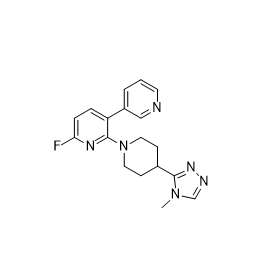| Cas No.: | 2117405-13-5 |
| Chemical Name: | 6'-Fluoro-4-(4-methyl-4H-[1,2,4]triazol-3-yl)-3,4,5,6-tetrahydro-2H-[1,2';3',3'']terpyridine |
| Synonyms: | SEN177,SEN 177 |
| SMILES: | CN1C(C2CCN(C3=NC(F)=CC=C3C4=CC=CN=C4)CC2)=NN=C1 |
| Formula: | C18H19FN6 |
| M.Wt: | 338.39 |
| Purity: | >98% |
| Sotrage: | 2 years -20°C Powder, 2 weeks 4°C in DMSO, 6 months -80°C in DMSO |
| Description: | SEN177 is an inhibitor of glutaminyl cyclase (QPCT), thereby rescuing the Huntington's disease (HD)-related phenotypes in cell. |
| In Vitro: | SEN177 is a Glutaminyl cyclase (QPCT) inhibitor. Glutaminyl cyclase modifies N-terminal glutamine or glutamate residues to N-terminal 5-oxoproline or pyroglutamate (named QPCT). QPCT inhibits mutant huntingtin from forming aggregates, but also reduces aggregation of other aggregate-prone proteins containing polyQ or polyA repeats. SEN177 caused dose-dependent decreases in HTT aggregation by a mechanism that requires QPCT inhibition. SEN177 had in vitro activity against polyglutamine toxicity and was able to reduce aggregates in mammalian cells, primary neurons and in a Drosophila model. |

 DC Chemicals' products qualify for U.S. tariff exemptions. We guarantee no price increases due to customs duties and maintain stable supply, continuing to deliver reliable research solutions to our American clients.
DC Chemicals' products qualify for U.S. tariff exemptions. We guarantee no price increases due to customs duties and maintain stable supply, continuing to deliver reliable research solutions to our American clients.





















